Cleansing Sunday Dinner
Menu:
- Mixed Heirloom Tomato & Carrot Peel Chutney w/ Braised Tofu on Rice Crackers (Appetizer)
- Cauliflower and Garbanzo Bean Flour Kefta in Tomato and Onion Sauce (Main Course)
The Diet Direction: Cleansing
- % Calories from Fat = 20%
- % Calories from Carbohydrates = 63%
- % Calories from Protein = 17%
The Experience:
Learning from last cooking experience, I decided to get an early start this time – and it really paid off well! I arranged to go to the grocery store in the early afternoon and get the shopping experience out of the way. That left me several hours to do a slow and careful “mise en place” preparation. Given that the main dish would require two separate preparations that would need to be combined later on, I started putting together all the kefta ingredients together in a bowl, while getting the sauce going on the stove as well. The idea was, I might as well get the sauce and other items done first and set them aside and warm, increasing the heat just slightly before serving.
I wanted to make kefta balls, but I didn’t want to use anything too heavy. So the sauce became the heavier part of the dish, and the keftas light and moist. I had some challenges getting the right consistency, but after some careful trial and error, and adding water slowly (that was the trick!), I got the consistency I wanted.
After preparing the sauce and chutney and setting it aside, I started putting the appetizer together. After that was plated, I went ahead and served that right away. The guests got to munch on something while I worked on the main dish.
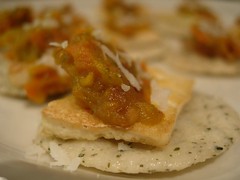
Mixed Heirloom Tomato & Carrot Peel Chutney
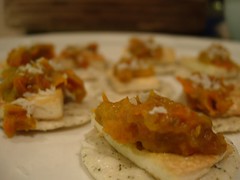
Often, I will get everything done and serve, but that means people have to wait, and sometimes feel hungry. This way, I make sure they’re not restless, and while they are milling about and munching, I get to escape and finish off the main item.
The keftas turned out very well. It was interesting that the sauce was not that well received – I actually thought it was good. But the feedback was they thought it was not the right kind of sauce or thickness for this dish.
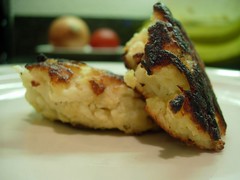
Cauliflower and Garbanzo Bean Flour Kefta
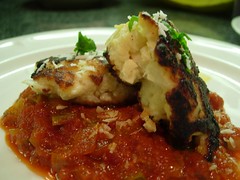
Keftas in Tomato & Onion Sauce
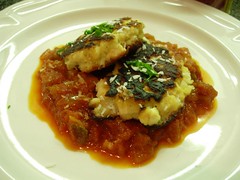
Plated and Garnished w/
Cilantro & Dried Coconut Flakes
Health Benefits
Asafoetida
The root of the word asafoetida, “asa” comes from the Persian “aza” which stands for “resin”. It is the sap or “resin” from the root of a giant fennel that dates back to before the 4th Century BC, when Alexander the Great was to have carried this westward to Rome. It carries a “vile odour” that has garnered English names such as “Devil’s Dung”, and “Devil’s Durt”.

Plated and Garnished w/
Cilantro & Dried Coconut Flakes
Cauliflower
This cruciferous vegetable in its most common form is white in colour – the large green leaves prevent it from getting any chlorophyll, which in this particular case is a good thing, because if it does, it doesn’t taste very good. It is high in Vitamin C and has a good source of Vitamin K.
Arugula
Arugula is actually a cruciferous vegetable as well (surprise!), and it contains large amounts of folate and calcium. In fact, it contains more than eight times as much calcium as iceberg lettuce (which is odd for a salad green). The dark green colour and bitter-tasting flavour come from the high levels of beta-carotene and Vitamin C (no other salad green has much Vitamin C as does arugula).


0 Comments:
<< Home